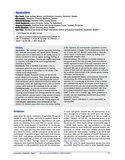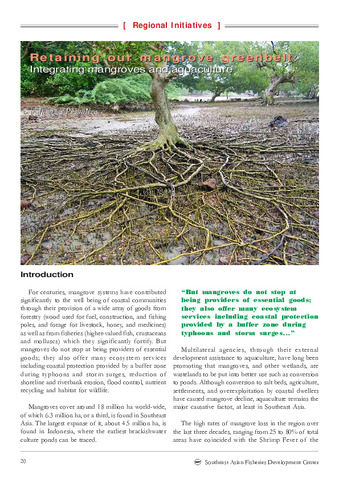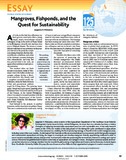Ecological role and services of tropical mangrove ecosystems: A reassessment
| dc.contributor.author | Lee, Shing Yip | |
| dc.contributor.author | Primavera, Jurgenne | |
| dc.contributor.author | Dahdouh-Guebas, Farid | |
| dc.contributor.author | McKee, Karen | |
| dc.contributor.author | Bosire, Jared O. | |
| dc.contributor.author | Cannicci, Stefano | |
| dc.contributor.author | Diele, Karen | |
| dc.contributor.author | Fromard, Francois | |
| dc.contributor.author | Koedam, Nico | |
| dc.contributor.author | Marchand, Cyril | |
| dc.contributor.author | Mendelssohn, Irving | |
| dc.contributor.author | Mukherjee, Nibedita | |
| dc.contributor.author | Record, Sydne | |
| dc.date.accessioned | 2015-05-22T08:40:08Z | |
| dc.date.available | 2015-05-22T08:40:08Z | |
| dc.date.issued | 2014 | |
| dc.identifier.citation | Lee, S. Y., Primavera, J. H., Dahdouh-Guebas, F., McKee, K., Bosire, J. O., Cannicci, S., … Record, S. (2014). Ecological role and services of tropical mangrove ecosystems: a reassessment. Global Ecology and Biogeography, 23(7), 726-743. | en |
| dc.identifier.issn | 1466-822X | |
| dc.identifier.uri | http://hdl.handle.net/10862/2247 | |
| dc.description.abstract | Aim To reassess the capacity of mangroves for ecosystem services in the light of recent data. Location Global mangrove ecosystems. Methods We review four long-standing roles of mangroves: (1) carbon dynamics – export or sink; (2) nursery role; (3) shoreline protection; (4) land-building capacity. The origins of pertinent hypotheses, current understanding and gaps in our knowledge are highlighted with reference to biogeographic, geographic and socio-economic influences. Results The role of mangroves as C sinks needs to be evaluated for a wide range of biogeographic regions and forest conditions. Mangrove C assimilation may be under-estimated because of flawed methodology and scanty data on key components of C dynamics. Peri-urban mangroves may be manipulated to provide local offsets for C emission. The nursery function of mangroves is not ubiquitous but varies with spatio-temporal accessibility. Connectivity and complementarity of mangroves and adjacent habitats enhance their nursery function through trophic relay and ontogenetic migrations. The effectiveness of mangroves for coastal protection depends on factors at landscape/geomorphic to community scales and local/species scales. Shifts in species due to climate change, forest degradation and loss of habitat connectivity may reduce the protective capacity of mangroves. Early views of mangroves as land builders (especially lateral expansion) were questionable. Evidence now indicates that mangroves, once established, directly influence vertical land development by enhancing sedimentation and/or by direct organic contributions to soil volume (peat formation) in some settings. Main conclusions Knowledge of thresholds, spatio-temporal scaling and variability due to geographic, biogeographic and socio-economic settings will improve the management of mangrove ecosystem services. Many drivers respond to global trends in climate change and local changes such as urbanization. While mangroves have traditionally been managed for subsistence, future governance models must involve partnerships between local custodians of mangroves and offsite beneficiaries of the services. | en |
| dc.language.iso | en | en |
| dc.publisher | Wiley | en |
| dc.title | Ecological role and services of tropical mangrove ecosystems: A reassessment | en |
| dc.type | Article | en |
| dc.identifier.doi | 10.1111/geb.12155 | |
| dc.citation.volume | 23 | |
| dc.citation.issue | 7 | |
| dc.citation.spage | 726 | |
| dc.citation.epage | 743 | |
| dc.citation.journalTitle | Global Ecology and Biogeography | en |
| dc.subject.asfa | management | en |
| dc.subject.asfa | mangroves | en |
| dc.subject.asfa | ecosystem services | en |
| dc.identifier.essn | 1466-8238 | |
| local.subject | Carbon dynamics | en |
| local.subject | ecosystem services | en |
| local.subject | land building | en |
| local.subject | management | en |
| local.subject | mangroves | en |
| local.subject | nursery function | en |
| local.subject | shoreline protection | en |
Files in this item
| Files | Size | Format | View |
|---|---|---|---|
|
There are no files associated with this item. |
|||
This item appears in the following Collection(s)
-
Journal Articles [1258]
These papers were contributed by Department staff to various national and international journals.




